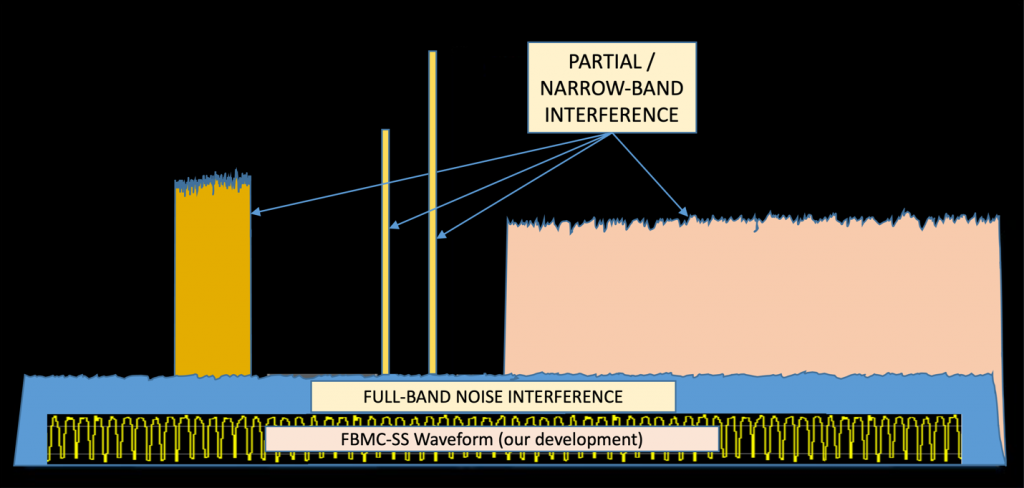Filter bank multicarrier spread spectrum (FBMC-SS)
Funded by: DOE, Idaho National Laboratory
PI: Behrouz Farhang-Boroujeny
Project Summary
FBMC-SS, the outcome of a collaboration of our lab with the Idaho National Laboratory (INL), was first proposed in 2010 as a resilient and spectrum agile waveform to be used as a control channel is setting up cognitive/adaptive radios. In the past decades many aspects of this waveform have been explored by a number of MS/PhD students/graduates of our lab. After graduation, a few of these students joined INL and continued the same line of research in implementing FBMC-SS in a number of use cases of interest to the US government.
Our research at the university side has led to development of a number of signal processing algorithms that has made FBMC-SS an excellent choice for the use cases that are being implemented at INL. The key developments along this line are:
- An analysis of FBMC-SS waveform that revealed its key properties was part of Dr. Daryl Wasden who graduated in 2014.
- Being a spread spectrum signal and, thus, possibly received at some level below the thermal noise, detection of incoming FBMC-SS packets was a buttle neck in implementing FBMC-SS receiver in the early days of its development. A novel algorithm, called “K out of M”, was developed by Dr. Taylor Sibbett who defended his PhD thesis in October 2018. The “K out of M” algorithm explores the output of a filter that is matched to the transmitter pulse-shape and decides on the presence of an incoming packet when K out of M recent impulses, separated by the symbol interval, are seen at the same timing phase. Excellent performance of this detection algorithm has been shown in practical implementations of FBMC-SS in INL.
- Our initial vision was to develop FBMC-SS to be able to operate in an environment with a high level of interference; see the below picture where some interferers may be many tens of decibels above the FBMC-SS. As we researched into FBMC-SS, we developed an algorithm that can blindly reject any high-power interference while passing it through a matched filter. The particular form of the matched filter that is used for this purpose was named normalized matched filter (NFM), reflecting the fact that the signal power is normalized at each subcarrier band of the FBMC. Excellent performance of this algorithm is demonstrated in the system implementations carried in INL. This algorithm has been analyzed in Dr. Taylor Sibbett thesis.
- A current PhD student of our lab, Mr. David Haab, as part of his thesis, has developed a full receiver structure for FBMC-SS based on the NMF. This new design reduces the complexity of the receiver and improves its performance.
- A full theoretical analysis of FBMC-SS in multipath channels, including RAKE receiver form of it, was performed by Dr. Stephen (Andy) Laraway who defended his PhD in December 2018.
- Arslan Majid developed a physical layer security scheme for FBMC-SS.
- Various radios that adopt FBMC-SS as their waveform have been developed at INL, with some contributions from our students.
- One particular class of transceivers that we have heavily experimented with are those that use refraction of electromagnetic waves in the ionosphere to transmit information over hundreds or thousands of miles around the globe. The carrier frequency that is used for this type of communication belongs to HF (high frequency) band which spans from 2 to 8 MHz. This frequency band is heavily used by amateur/ham radio users who wish to perform some fun experiments. It also had wide applications in the older days of the radios. More recently, HF radios have been reconsidered for some emergency and military applications where cellular and satellite radio networks may collapse because of some natural or man-made disasters. FBMC-SS is sought as a novel solution that may be able to resolve some of the problem of the past generations of HF modems. Thus, our lab activities in this direction continues. A setup that establishes an HF link between INL in Idaho Fall, Idaho, and Salt Lake City, Utah, is frequently used for our experiments.

FBMC-SS waveform tolerates Full-band, Half-band, Partial-band and Narrow-band interference as shown above. Partial and Narrow-band interferences may be tens of decibels above the FBMC-SS signal.
